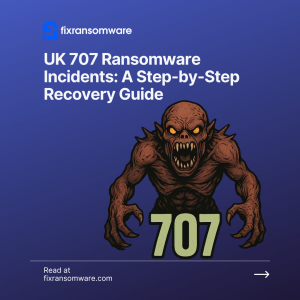A 707 incident can halt operations, encrypt servers, and pressure teams to pay. Don’t. Your objective is to contain, preserve evidence, and restore cleanly without re-introducing the threat. This UK-focused guide gives a pragmatic path you can execute now. If you need hands-on help, start an assessment at FixRansomware.com.
Symptoms and First Moves
Common signs include mass file locks, unusual write spikes on storage, ransom notes, and disabled backups. Priorities:
- stop lateral movement,
- capture artifacts for forensics and insurance,
- prepare a clean restore plan.
For baseline response principles, see CISA Stop Ransomware and the UK NCSC incident management collection.
Contain 707 without Breaking Evidence (First 30 Minutes)
- Isolate affected hosts or VLANs. Disable uplinks or switch ports; don’t hard power-off unless required for safety.
- Quarantine shared storage and revoke non-essential admin access.
- Capture evidence: ransom note, timestamps, affected asset list, suspicious processes, recent admin logins, backup failures.
- Do not rename/overwrite encrypted data, merge snapshots, or run random “decryptors.” Preserve the current state for analysis.
Clean Restore Strategy for 707 (ESXi/Hyper-V/NAS)
Your goal is a clean, verifiable restore that avoids corruption and reinfection.
1) Prepare a landing zone.
Use a patched, credential-fresh environment separate from production. Create an isolated network for testing restores.
2) Validate backups.
Only use pre-incident backups from repositories that 707 could not modify (immutable/offline). Start with a single test VM or file set; verify boot, services, logs, and data integrity before scaling up.
3) Orchestrate by business priority.
Restore in order: Identity/Directory → Database → App/API → Frontend. Keep network fencing until hardening completes. If the OS is compromised but data volumes appear intact, build a clean OS and attach data disks read-only to validate before switching to read-write.
4) Prevent corruption.
Run filesystem checks and, for databases, verify transaction/redo logs before opening to users. Always keep a forensic image of recovered media.
Forensics That Matter in a 707 Case
- Likely vectors: exposed management portals, credential reuse/leaks, weak MFA, or compromised RDP/jump hosts.
- Collect host logs, identity provider logs, EDR telemetry, backup/audit trails, and change histories in your hypervisor/central management.
- Preserve read-only images of critical systems; they’re vital for claims, regulatory reporting, and post-mortems.
Hardening After 707 to Prevent Repeat Attacks
- Identity & Access: Enforce MFA everywhere (vCenter/ESXi/Hyper-V, VPN, admin portals). Rotate all service and local admin credentials; end shared accounts.
- Patch & Surface Reduction: Patch hypervisors, OS, and edge services. Remove unused ports/services. Strictly separate management and production networks.
- Resilient Backups: Apply 3-2-1 with at least one immutable/offline copy. Test restores regularly (table-top plus live drills).
- Monitoring & Detection: Use EDR to spot mass-encryption behaviour and abnormal write rates. Feed logs to a SIEM and alert on suspicious admin activity.
- Runbook & Exercises: Maintain a clear incident runbook (roles, SLAs, escalation). Drill quarterly so teams execute under pressure.
When to Call Specialists
If you face unclear blast radius, broken backups, or complex platforms (e.g., ESXi clusters, clustered databases, or NAS at petabyte scale), bring in specialists. FixRansomware.com provides rapid triage, scoped clean-restore, and hardening guidance that aligns to UK best practices—no ransom required.


